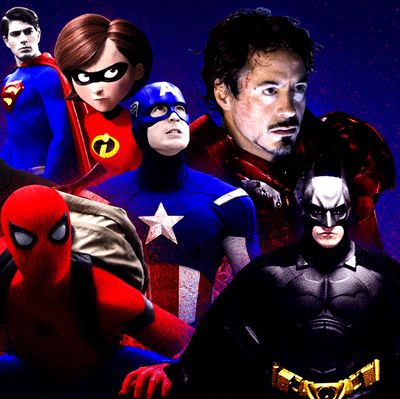
This list was first published in 2014, and has been updated periodically to reflect new superhero movie releases.
In 1998, predicting a fiscally and artistically rich superhero-movie industry would’ve gotten you laughed out of your local comics shop. Hell, the idea of an “industry” for movies about costumed heroes was ludicrous. No such thing had ever existed. Superhero movies had been few and far between throughout cinema history, and the then-most-recent superpowered flick had been 1997’s Batman and Robin — a movie so derided that George Clooney has spent 20 years apologizing for it. Then Wesley Snipes came along and changed everything. On August 21, 1998, Blade was released and audiences watched Snipes don the shades of the titular vampire-stabbing superhero (a longtime Marvel Comics staple). The picture earned more than $131 million worldwide. Quietly, a revolution began.
In the nearly two decades since, successful caped-crusader movies started trickling, then flooding, into theaters. Now we live in a world where the global film economy is largely built on them. The so-called Marvel Cinematic Universe alone has raked in more than $10 billion to date, and when a movie like Batman v Superman: Dawn of Justice makes $872 million, it’s regarded as something of a disappointment. Studios announce their superhero slates like Stalin announced five-year plans. High-profile directors get attached to adaptations of comics few have ever heard of. It sure feels like we’re in a bubble, but there’s no sign it’ll pop anytime soon — and even when it does pop, there will be plenty of products of this spandex-clad era worth rewatching. Here are the 30 best superhero movies since Blade kicked off their modern renaissance.
But first, let’s talk methodology. Our criteria for what constitutes a superhero movie are as follows: It must (a) be about a do-gooder or group of do-gooders who either have superhuman abilities or are more skilled at crime-fighting than any real-life human possibly could be (Batman and the Punisher being examples of the latter); (b) be set primarily on Earth, which excludes sci-fi fantasias like Star Wars and Guardians of the Galaxy, as both are set in galaxies where superhuman abilities are commonplace; and (c) have been released theatrically. There’s also a certain amount of Potter Stewart–esque logic here: You know a superhero when you see one.
30. The Dark Knight Rises (2012)
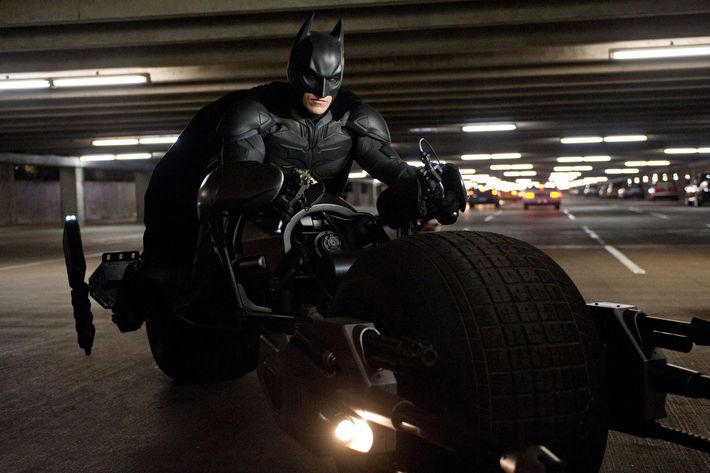
There’s a lot about the final chapter of Christopher Nolan’s Batman trilogy that doesn’t quite work. To name a few problems: Bane and Catwoman have barely intelligible motivations, Batman ends the movie by flat-out retiring, and the plot’s politics are so cartoonishly reactionary that even the most die-hard Republican might say they’re a bit much. But boy, oh boy, is it pretty. This is one of the most visually sumptuous tentpole movies of recent years, with one breathtaking sight after another. The eerily quiet overhead shots of Gotham’s bridges exploding, the disappearing football field, and the stunning airplane-hijacking sequence are just a smattering of the highlights. And people really undervalue Tom Hardy’s line readings. Sure, the audio distortion is overdone, but he created a unique bad-guy voice in the cinematic canon, which is nothing to sneeze (or wheeze) at. If you haven’t entertained yourself by saying “Perhaps he’s wondering why someone would shoot a man … before throwing him out of a plane!” in a Bane voice to yourself while alone, you’re really missing out.
29. Dredd (2012)
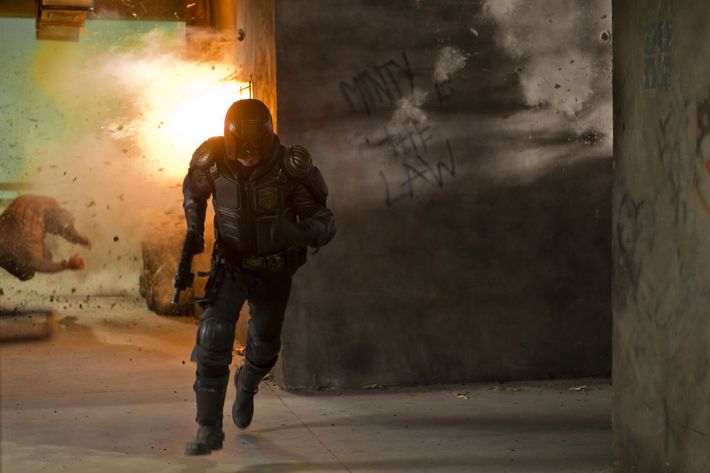
Despite being an American, Judge Dredd (and, yes, that is his real last name) is only a big star in the United Kingdom. The scowling enforcer of postapocalyptic justice is one of the most famous characters to ever emerge from British comics, but he’s sadly never caught on here. This slimly budgeted film adaptation didn’t change that fact — it landed with a thud at the box office and has barely even become a cult classic. That’s a damn shame, as Dredd is a compact delight. In less than 90 minutes, it gives us deliciously violent action, a hypnotic electronic score, and just-this-side-of-over-the-top performances from Karl Urban and Lena Headey. Plus, the whole thing’s about as decadent an ode to slo-mo as any movie ever released.
28. Big Hero 6 (2014)
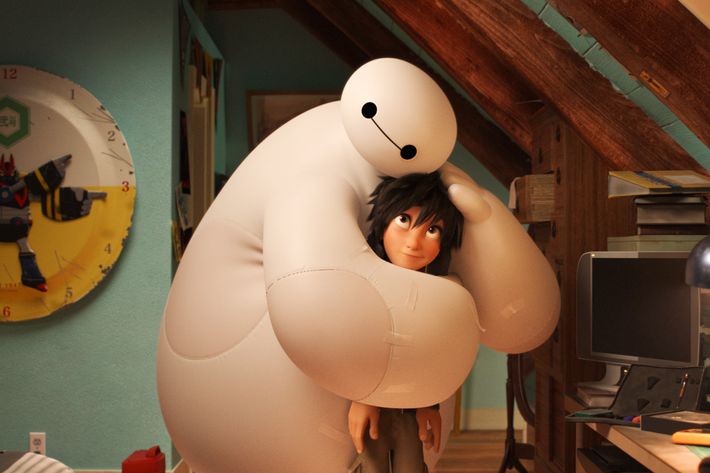
At its core, this is a movie about how one person’s death can suck the air out of a family and a community. Given how little regard the average superhero movie has for mortality (what with all the building-smashing and world-exploding), Big Hero 6’s confrontation with grief is remarkable. Sure, it’s a thrill to watch the high-flying action sequences in the movie’s surreal mash-up of Tokyo and San Francisco, and anyone with a heart will enjoy the inflatable “health-care companion” robot Baymax. But what really sticks with you is Baymax’s clinical, repeated line of questioning to boy-genius protagonist Hiro: If we beat the bad guy, will that improve your mental health? It’s a simple twist on the old “If I kill the villain, I’ll be just as bad as he is” routine, but a twist that has considerable emotional weight.
27. X-Men (2000)
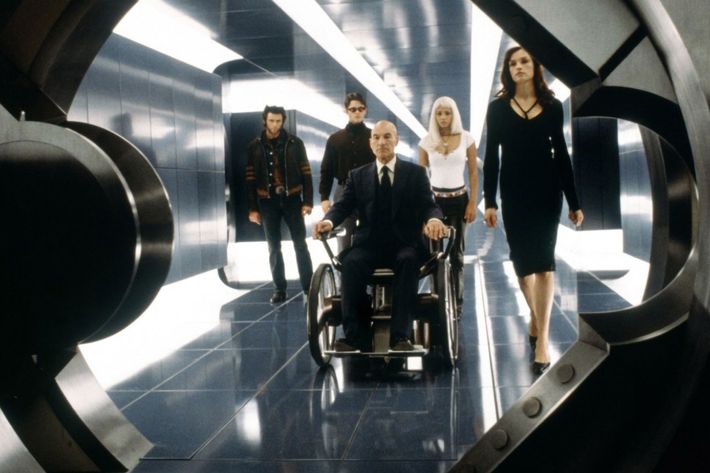
In retrospect, it’s astounding how good the casting in X-Men was. At the time, superhero movies were still mostly a dead letter in Hollywood, and the marquee names of the day wouldn’t touch a movie like this. So Bryan Singer took the Moneyball approach: Almost everyone he snagged was either undervalued in the market (Patrick Stewart and Ian McKellen), underestimated as a pretty face (James Marsden and Rebecca Romijn), or a near-complete unknown (Hugh Jackman). Sure, there are duds in the lineup (Tyler Mane’s and Ray Park’s presences here are best left alongside the Y2K virus as turn-of-the-millennium curiosities), but the synergy of this cast of misfits still provides a frisson of delight. It’s not a great film, but it was solid enough and exciting enough to rescue the superhero genre from obscurity. Although Blade came first, it was X-Men that really made the rest of this list possible.
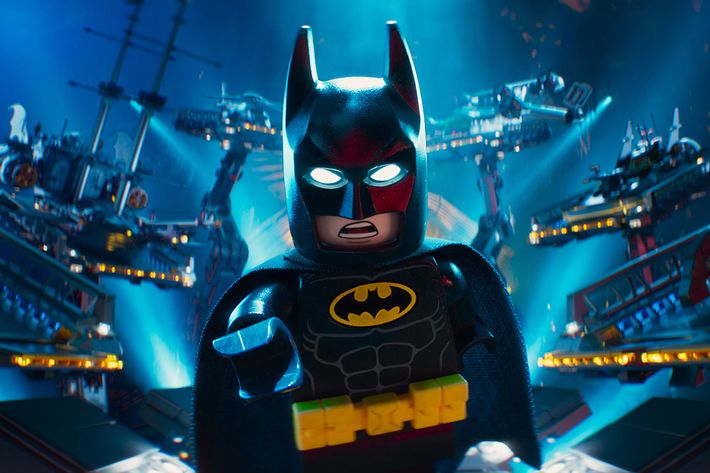
26. The Lego Batman Movie (2017)
There’s this myth that all Batman stories have to be dark. These days, you hardly ever see a tale about Batsy in print or film that doesn’t feature heavy doses of angst and meditations on the brutality of daily life. But the fact is that the character can be quite fun and goofy and often has been, such as in the Batman TV show from the late 1960s and his comics adventures from the late ’40s to the early ’70s. Usually, Batman movies pretend that stuff never happened, but The Lego Batman Movie is a blissful exception. It takes the fundamentally ludicrous core of the character — angsty man-child who dresses like a rodent — and embraces them, along with various silly elements of his past incarnations. And yet, somehow, it also produces its own kind of pathos in the form of Will Arnett’s Batman’s repressed longing for a family. The voice cast is jam-packed with great performances from top-flight personalities like Zach Galifianakis and Rosario Dawson, and the Lego-fied visual gags never get old. Anyone who turns their nose up at this flick should ask themselves whether they’re truly a Batman fan.
25. Chronicle (2012)
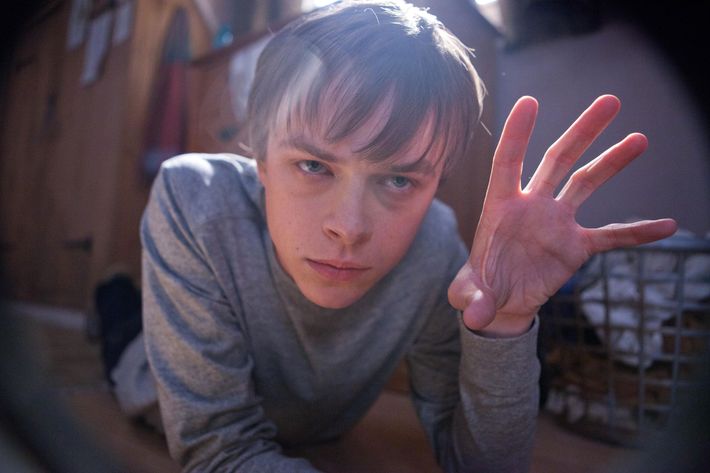
Superhero stories have long been derided as power fantasies for emotionally stunted adolescent boys. Josh Trank and Max Landis’s terrifying Chronicle takes that criticism and turns it on its ear, asking what would happen if emotionally stunted adolescent boys actually got to live out such power fantasies. It’s unsparing in its answer: They’d raze the world. The movie, in its first two-thirds, is chilling not only because of its deft use of found-footage-horror tropes, but also because it depicts teenage male privilege at its most venomous and sociopathic. Just watch the scene where Dane DeHaan’s Andrew telekinetically rips out a bully’s teeth in the hall of his high school and, if you’re a dude, ask yourself if you didn’t have fevered revenge fantasies like that when you were his age. The final act turns into a generically explosive good-against-evil showdown, but up until that point, Chronicle is something genuinely terrifying and original. Trank has a deep admiration for the superhero genre and knows how to take it into the darkness without making your eyes roll. It’s too bad we’ll probably never see his fabled first cut of Fantastic Four — even if it’s bad, it’s undoubtedly fascinating.
24. Spider-Man (2002)
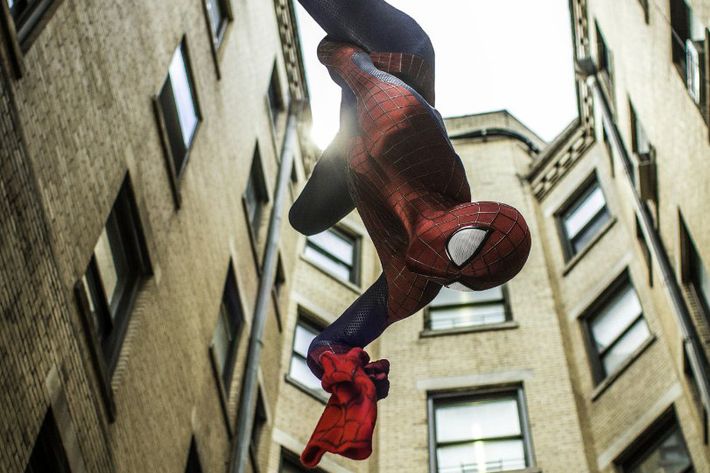
Tobey Maguire was a supremely, delightfully odd choice to play Spider-Man. He’s not particularly funny, for one thing, and sharpened wit is a central aspect of the Spidey archetype. That archetype also requires relatable humanity, and Maguire’s mannerisms and line readings in Spider-Man give off the vibe of an alien wearing a human suit. But his performance, like the rest of Sam Raimi’s Spider debut, is as charming as it is awkward. Here is a movie where no one seems to be in the same movie, what with Willem Dafoe seemingly bored by everyone except himself (and he is fascinated by himself), James Franco operating in the transition zone between heartthrob and holier-than-thou artiste, Kirsten Dunst thinking she’s in another teen drama, and Maguire speaking directly to the viewer with his aforementioned eerie inelegance. Oh, and Macy Gray is there, too, for some reason. The result is an uneven mishmash that, nevertheless, confidently set the template for solo superhero origin stories.
23. Wonder Woman (2017)
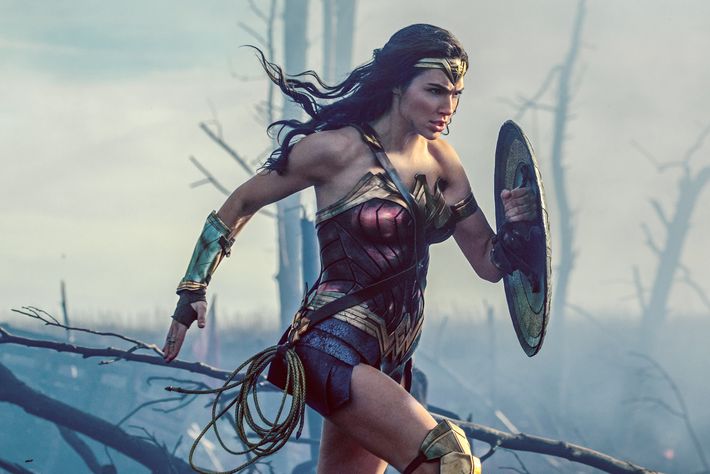
To watch Wonder Woman in theaters during its debut run is to watch movie history being made. The mere act of seeing it was somewhat significant, given that it was the debut feature for the most famous female character to ever emerge from superhero fiction — and given that it swiftly became one of the most lucrative movies ever crafted by a female director. Luckily, it isn’t just momentous; it’s actually very enjoyable. Gal Gadot turns in a stunning performance as the titular warrior, one woven with an earnestness that’s all too rarely seen in today’s quippy, sarcastic superhero-film industry. Chris Pine is a total delight as the male damsel in distress. (Call him a dude in dire circumstances, perhaps.) Though she’s only in a few minutes of the picture, Robin Wright is fantastic as Wonder Woman’s mentor. The third act is dull and rote, but the rest of it is as charming as it is thrilling. When the movie needs to be funny, it’s hilarious, which is a welcome difference from its compatriots in the DC Extended Universe.
22. Thor: Ragnarok (2017)
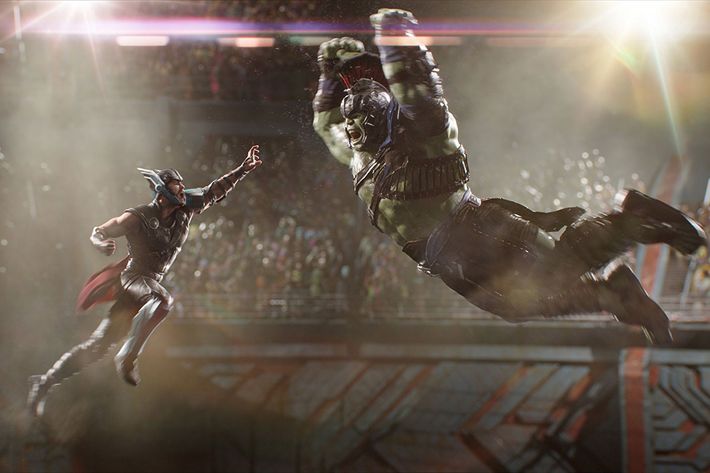
If this were a ranking of superhero-movie press tours, Thor: Ragnarok would shoot straight to the top. Director Taika Waititi filled nearly every interview with mirth and charming irreverence, openly acknowledging, for example, that he only glancingly paid attention to the script for many of the film’s scenes. It was a delightful way to let some of the hot air out of the superhero genre and acknowledge its fundamental silliness while still standing behind the product he helmed. That silliness permeates Ragnarok, which is perhaps the most chuckle-filled Marvel Studios film so far — and that’s a competitive category. Jeff Goldblum’s turn as an effete dictator of an alien world is particularly fun, but the breakout performance comes from Tessa Thompson as reluctant warrior Valkyrie. The movie stumbles when it tries to add thematic ballast, but even there, its heart is in the right place: Cate Blanchett’s death-goddess Hela delivers a notable critique of superhuman colonialism, which is an ambitious choice for a kid-friendly flick. Plus, Waititi voices the movie’s best supporting character, a chill, Kiwi-accented rock-beast named Korg who wants to start a revolution, but doesn’t want to bother you too much if you’re busy. Taika, please stick around; the game needs you.
21. Captain America: The First Avenger (2011)
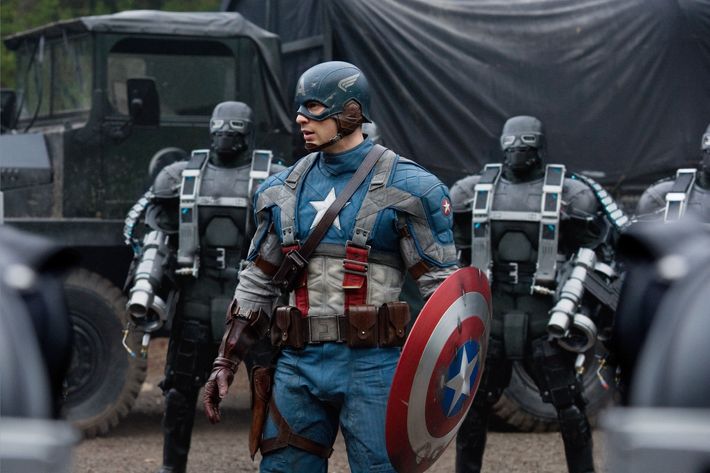
It’s totally justifiable to groan at this movie’s politics. It’s unashamedly jingoistic in its nationalism, building its story on the notion that our boys were wholly stalwart defenders of all that’s decent in the world. But if you’re willing to accept the fantastical notion of a “super-soldier serum,” why not suspend your disbelief and accept the equally ridiculous idea of American righteousness for a few hours? If you do, there’s much to enjoy in The First Avenger, from Chris Evans’s aw-shucks earnestness to Hugo Weaving’s Werner Herzog impersonation; from Hayley Atwell’s pencil-skirt-wearing lethality to Toby Jones’s hand-wringing weaseliness; from the sumptuous mid-century décor to the fist-pumping final (well, final before the credits) scene. This is a pretty standard-issue World War II–movie story, but that’s kinda the point — and it’s executed deftly.
20. Captain America: Civil War (2016)
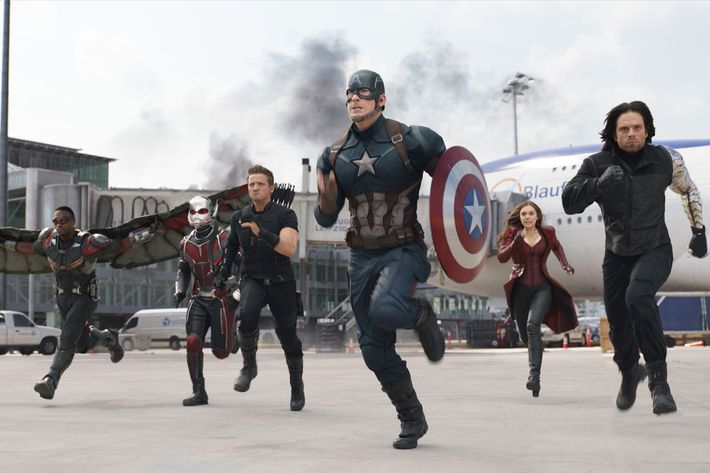
For all its bombast about government oversight and the bonds of friendship, Captain America: Civil War’s magic lies in familiarity. Watching it is like watching a very good episode of a long-running television show as the characters you’ve come to know squabble over a grievance that’s more story prompt than thematic foundation stone. There isn’t much new here, but there’s a tremendous amount of craft: gasp-inducing action sequences, solidly funny dialogue, a masterful balance of attention among the massive cast of characters, a wise decision to not waste time on origin stories, and that weird little scene that resurrects Less Than Zero–era Robert Downey Jr. The cacophony of critical praise was too loud, but there’s a lot to love in Civil War and very little to hate.
19. Sky High (2005)
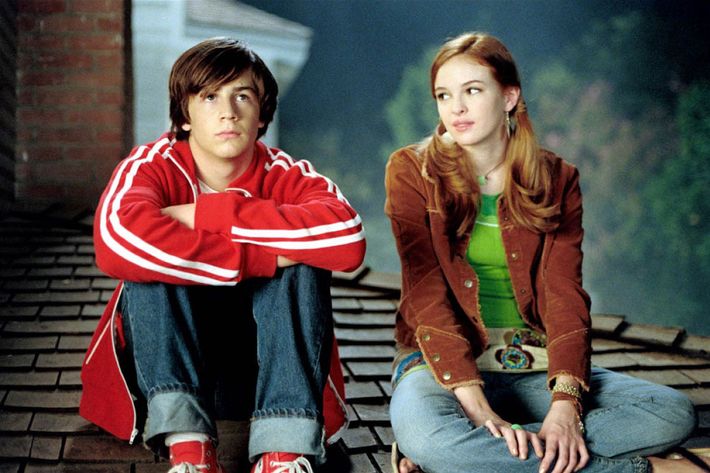
I will shamefully admit that I had been writing about the superhero industry for years before I saw Sky High. I figured — and I’m sure I’m not alone here — that a Disney movie from the director of Deuce Bigalow: Male Gigolo about a metahuman high school could only be fluffy garbage. Mea maxima culpa, folks — Sky High is actually a huge winner. It’s one of the most genuinely funny superhero comedies ever made, built on a healthy mix of genre pastiche and finely tuned character relationships. The lead, Michael Angarano, may be an unknown to you, but you’ll thrill at the insanely talented supporting cast: Kurt Russell as an adorable superdad, Lynda Carter as the hard-ass principal, Bruce Campbell as the overwrought gym teacher, Kids tn the Hall’s Dave Foley and Kevin McDonald as risible teachers, and a fantastic performance from a young Mary Elizabeth Winstead. It’s a bit like Mean Girls meets The Avengers, but it’s also its own delightfully unique creature that deserves much more applause than it gets.
18. Hellboy (2004)
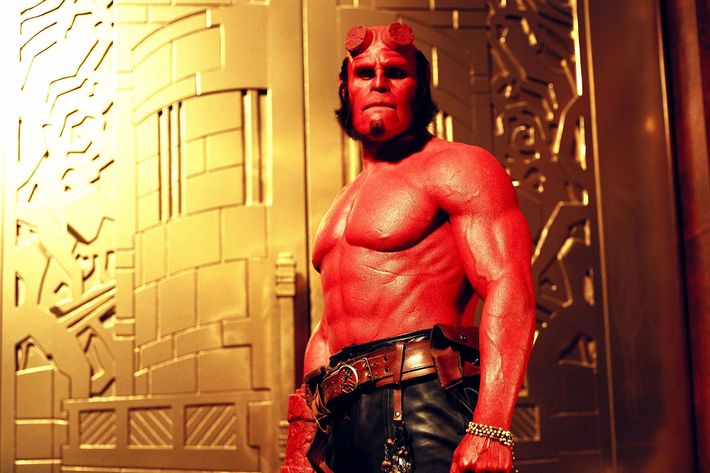
Let’s focus on the most important element of this movie — one that, thanks to today’s foregone conclusion of motion-capture CGI, is probably unlike anything we’ll ever see again in a superhero movie: Ron Perlman’s beautiful Hellboy suit. When we first enter his cat-filled lair and see him — red paint enveloping his face, muttonchops gummed to his temples, heavy half-horns on his brow, giant glove on his fist — there’s a gravity and reality to him that we’ll never experience in, say, Mark Ruffalo’s video-game Hulk. From there on out, Guillermo del Toro’s superhero opus is visually grounded, even when it has an immortal Rasputin casting nasty demon-spells. The bad guys have clockwork battle-suits that must have been hell to build and wear but are worth every bit of sweat and patience. The alleys and tunnels feel dank and lived-in. Even the merman Abe Sapien defies subsequent genre conventions: Instead of just having David Hyde Pierce lend his voice to a ones-and-zeroes construct, the onscreen work is done by the elegantly wiry Doug Jones in unforgettable creature makeup. It helps that the plot is engrossing and well-paced, but what launches this movie into the canon is del Toro’s world-building, which is somehow as dreamlike as it is tactile.
17. X2: X-Men United (2003)
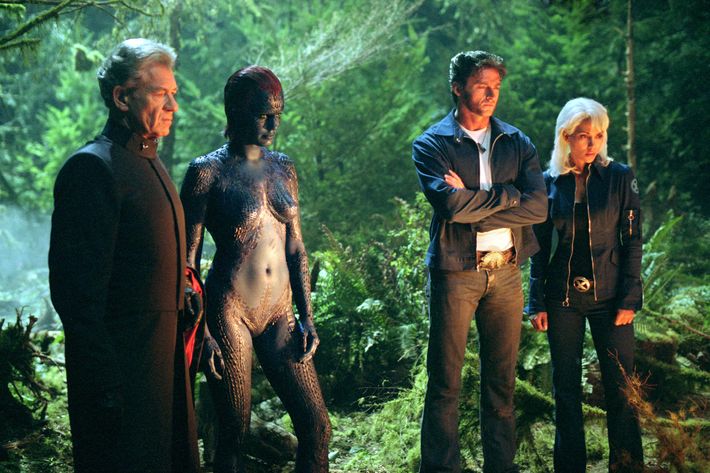
Real talk: The first five minutes of this movie are better than most of the superhero movies ever made. If X2 could sustain the raw cinematic thrill of Nightcrawler’s teleported invasion of the White House, it would have no peer on this list. That White House scene sets the tone for the movie’s exemplary superpower sequences, which are unfailingly elegant and free of post-Bourne action filmmaking’s choppy-chop-chop confusion. Consider, for example, Ian McKellen’s Magneto calmly levitating a hapless guard whose blood has been filled with metal. Or Hugh Jackman’s Wolverine using his claws to skewer a black-ops soldier into a refrigerator. The action is pulse-pounding and the story is just compelling enough. And c’mon, how great is Brian Cox as Svengali mastermind Stryker? (Has there ever been a bad Brian Cox performance?) Plus, there’s a bit of dialogue between Mystique and Nightcrawler about passing that, though brief, is more boldly progressive than virtually any other scene in the superhero genre. Now, if only the X-Men had more nonwhite, non-straight people on their team …
16. X-Men: Days of Future Past (2014)
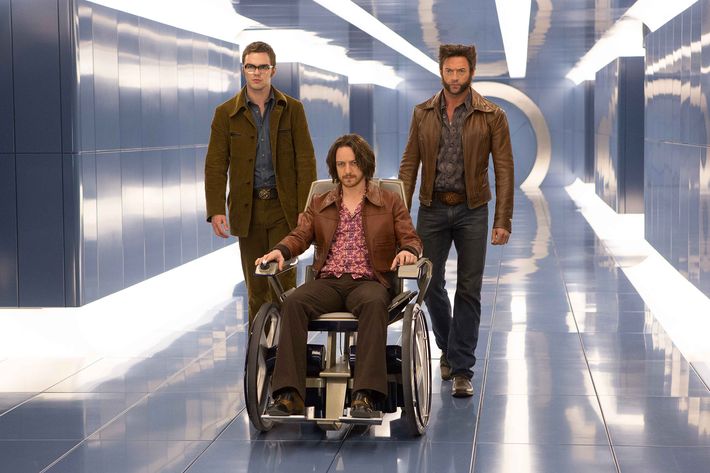
In the wake of 2016’s flaccid X-Men: Apocalypse, it’s become fashionable to say the lo(ooooo)ng-running X-Men franchise needs to be taken out back and shot. But just one movie prior, it produced its best installment. Days of Future Past is like a mixtape of all the best parts of its predecessors: vividly choreographed fight sequences (Fan Bingbing’s Portal-aping, mostly silent turn as Blink is particularly great), terrifically offbeat comedy (c’mon, who doesn’t love that Quicksilver scene?), sensationally weird period-piece touches (JFK being a mutant, Mystique showing up at the Paris Peace Accords), and — perhaps most important — the endless charms of Hugh Jackman, Patrick Stewart, and Ian McKellen, who had settled into a loving synergy with one another 14 years after they first shared the screen. The gentle final scene would’ve been a perfect capstone to the franchise. For now, it feels like a shame that it wasn’t.
15. Iron Man (2008)
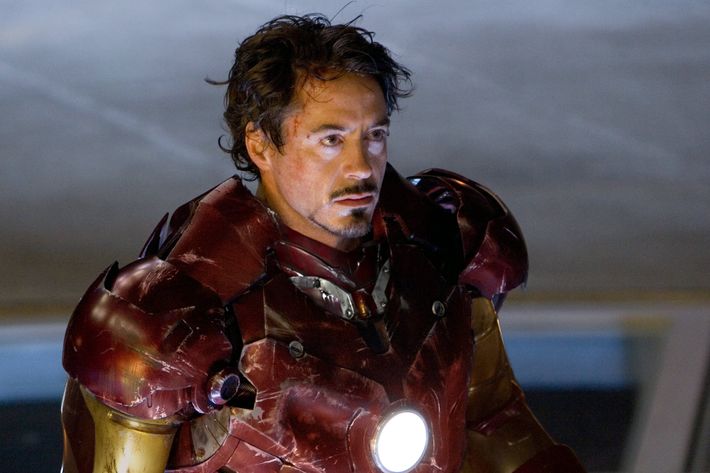
The film that kicked off the Marvel Cinematic Universe spends a troubling amount of time gleefully killing off unnamed brown people and has a deeply muddled ethical schema (Tony Stark gets disillusioned with weapons manufacturing, so he … builds a murderous battle-suit?). But the stuff it gets right changed modern cinema. Rarely has a single movie set the tone for an entire subgenre, yet Jon Favreau and Robert Downey Jr. managed to build the Marvel Movie template and tone from whole cloth here. You’ve got the witty banter, the bright colors, the clever pop-culture references, the Playstation-ready final CGI showdown, and the charming lead. Oh, how charming he was. RDJ’s breathtaking charisma and unmistakable comedic rhythms made you sit up in your seat in a way that, say, Tobey Maguire or Christian Bale never could. Ever since, Marvel has built its empire on the backs of dudes (and, sadly, they really are all dudes) who can hit RDJ-esque beats: most notably Chrises Evans, Hemsworth, and Pratt. But most important, there was that post-credits sequence in which the vision of Ultimate Marvel came true and Samuel L. Jackson appeared as Nick Fury. It promised the vast world we now inhabit.
14. Hellboy II: The Golden Army (2008)
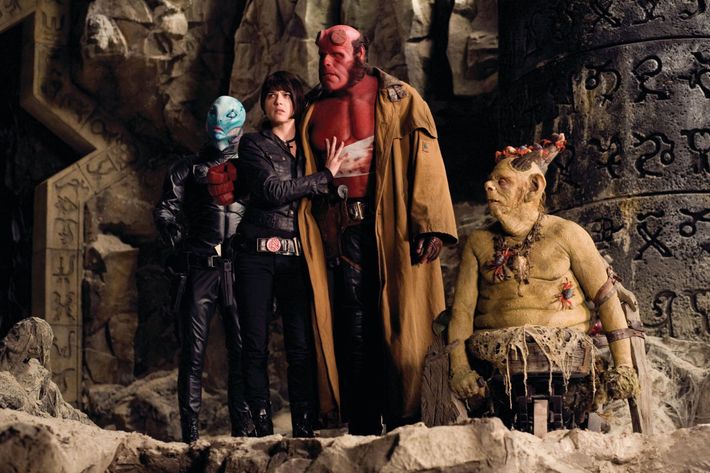
The second Hellboy is even better than the first, and the reasons are simple: Guillermo del Toro looked at the first Hellboy and gives us (a) more of what had worked and (b) less of what hadn’t. He jettisoned the previous movie’s yawn-inducing audience surrogate John Myers, as well as Hellboy’s textbook crisis of confidence. Instead, del Toro presents even more steampunk gadgets and supernatural bazaars, along with heaping helpings of charming dialogue for Ron Perlman, Selma Blair, and Jeffrey Tambor. I can’t believe I’m saying this, but Seth MacFarlane is straight-up delightful as the voice of a suit filled with sentient German ectoplasm. It’s deeply frustrating that del Toro has indefinitely suspended his plan to make a movie about DC Comics’ various magician characters, because if it were even half as giddy and chilling as Hellboy II, it’d be the most innovative DC film adaptation to date.
13. Punisher: War Zone (2008)
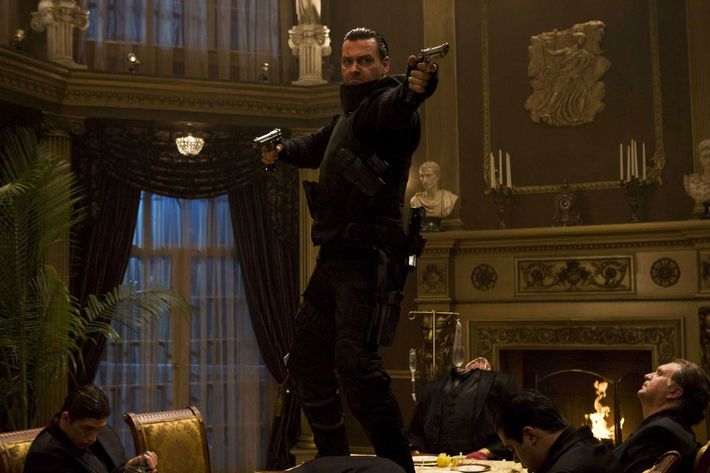
Good lord, is this a wonderful little movie. Before we go any further, I must recommend the episode of the How Did This Get Made? podcast that tackles this bomb/masterpiece and features long discussions with its director, Lexi Alexander. I also have to recommend that you seek out the flick itself and bask in its bonkers B-movie glow, because odds are you haven’t seen it. It has nothing to do with the 2004 Punisher movie, bears little resemblance to any other superhero film (if anything, it takes its cues from ’80s urban-vigilante pictures like Cobra), and it’s somehow both exhilarating and deliberately hilarious. It follows the titular lethal enforcer (played by Ray Stevenson with the passion of an actor who is praying this could be his big break) as he goes to war with facially scarred mobster Jigsaw (a scene-gnawing Dominic West) and Jigsaw’s deranged brother (portrayed by the possibly actually insane Doug Hutchison). It’s taut, it’s inventive, and it’s tragically overshadowed by its fellow 2008 flicks Iron Man and The Dark Knight. Those latter two subsequently locked superhero movies in templates that mostly exclude the wild excitement of Alexander’s forgotten gem.
12. Spider-Man 2 (2004)
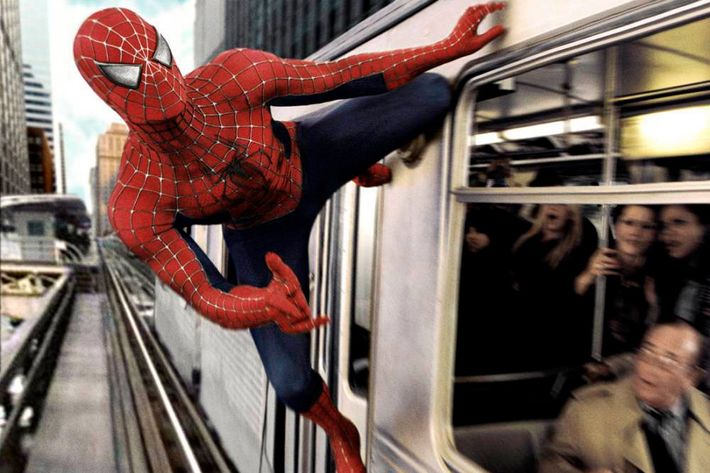
As stated before, Tobey Maguire isn’t a great fit for Peter Parker. But in Spider-Man 2, he nails the most important lesson of the character’s archetype: With great power comes great shpilkes and an inability to keep your life together. From the very beginning of the first Spider-sequel, Maguire gives us a Peter who lives up to the neurotic ideal set forth in 1962, one who simply cannot balance his quest for justice with his need for a steady job or his desire not to fuck up all his relationships. That kind of tension is far more agonizing to watch than any high-flying battle with Doctor Octopus — although let’s not throw Alfred Molina’s grandiose Doc Ock under the bus, because he’s a shirtless thrill and his serpentine faux-limbs will haunt your nightmares. Before the advent of the Nolan Batman trilogy and the Marvel Cinematic Universe, this was widely regarded as the best superhero movie ever made, and with good cause: Its leads are charming, its action is acrobatic, and its humor is grin-plastering (I mean, come on, that Bruce Campbell cameo alone, dude).
11. Spider-Man: Homecoming (2017)
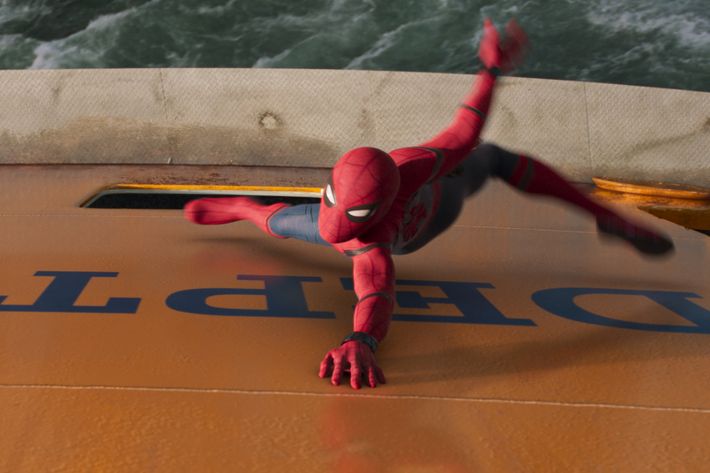
What’s weird about the filmic Spider-Man corpus is how often its movies have refused to be fun. Sure, all the Spider pictures have jokes, but they generally lean more on the pathos than the patter, emphasizing heroic struggle and depressing failure above all else. There’s a healthy dose of dire straits in Spidey’s formal entrance to the MCU, but what makes it really click is how charming and heartfelt it is. You find yourself just as excited about Peter Parker’s motley assemblage of Academic Decathlon teammates as you are about his alter ego’s battles with the Vulture. Speaking of which: Hoo-boy, Michael Keaton is great as that particular baddie. By the time he and Spider-Man are face-to-face, we’ve so fallen in love with awkward everyteen Peter that we feel genuine dread about the possibility of his coming into harm. Plus, Homecoming has A-plus cameos from Hannibal Buress and Donald Glover, so stop any and all whining and appreciate this extremely fun little flick.
10. Iron Man 3 (2013)
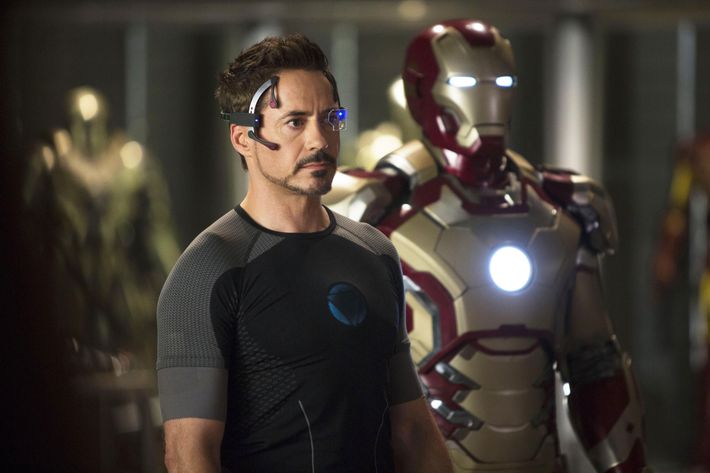
Superhero stories, at their best, are meditations on power, and this movie looks at an aspect of it that’s often ignored in the rest of the genre: the trauma that it can bring. If Tony Stark had never built himself that robot suit, he never would have found himself at the edge of death in The Avengers. But can he really regret having superhuman capabilities if they allowed him to save lives? That dilemma causes the goateed playboy to clutch his tightening chest over and over again in Iron Man 3, and it provides fertile ground for rich storytelling. Yet somehow, despite the frank depiction of PTSD, the film is also more fun than almost anything else in the Marvel Cinematic Universe. Shane Black, drawing on a screenplay he co-wrote with Drew Pearce, gives us a nimbly enchanting narrative. It hops from one colorful setting to another, showcasing pitch-perfect moments between Robert Downey Jr. and an array of talented performers: Guy Pearce, Rebecca Hall, Don Cheadle, Gwyneth Paltrow (better here than in any other of the franchise’s installments), and, most memorably, Ben Kingsley. That twist! Downey is at his sad-clown best throughout, managing to balance anguish with great little bits of comedic business such as his interactions with Adam Pally’s starstruck newsman Gary. But the finest moments come when Tony pals around with his prepubescent sidekick Harley, because Harley is our audience surrogate: He looks at Downey with awe when he’s being goofy and earnest concern when he’s struggling.
9. Captain America: The Winter Soldier (2014)
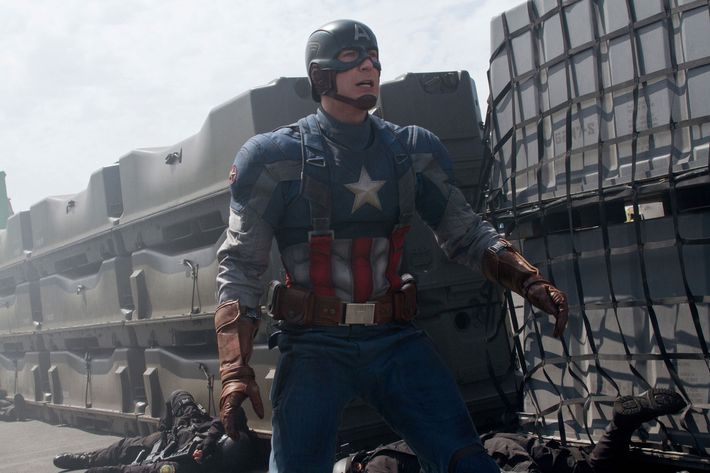
If you look at all the lead performances from the superhero boom, you won’t find one more relentlessly endearing than Chris Evans’s turn as Steve Rogers in the second Captain America movie. Just a few minutes in, we see the time-displaced dirty-blond attentively scribble down a note to himself on a piece of paper he keeps around to mark down things he missed while frozen (e.g., “Star Wars / Trek,” “Moon Landing,” “Thai Food”). How can you not greet that moment with a hearty awwww? Even when he’s clobbering a writhing mass of villains in an elevator or talking to a sentient Commodore 64, Evans/Rogers keeps us gripped with his sincerity and yearning. But Winter Soldier doesn’t solely rely on the winning nature of its lead. It also offers up a tonally claustrophobic story about conspiracy and complicity, one punctuated by rousing action sequences and lines pregnant with double meanings. It lets old hands like Robert Redford and Samuel L. Jackson have fun and mostly avoid comic-book-y jargon. And though it isn’t preachy or explicitly political, this is a movie about the shitty path that a demobilized soldier has to walk, knowing the world has left him behind and seeking fragile comfort in the presence of fellow warriors. The bond between Steve and his brainwashed buddy Bucky inspired reams of (often romantic) fanfiction even though the latter has fewer than 20 lines in the entire movie, which is a testament to the movie’s power: Unlike most superhero movies, Winter Soldier actually has subtext.
8. Superman Returns (2006)
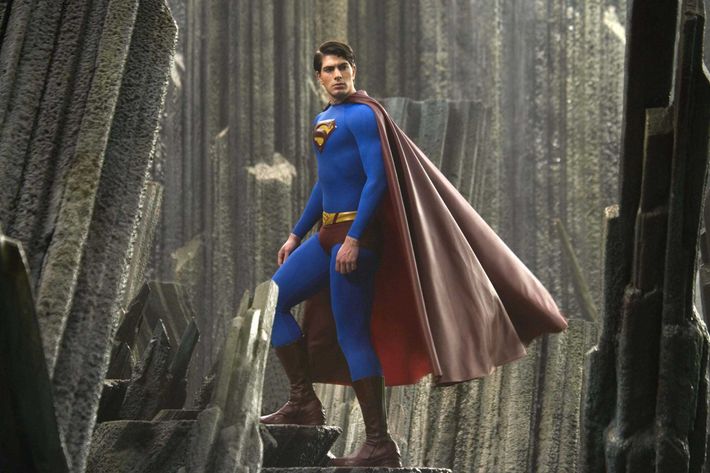
Okay, hear me out. Like most viewers, I despised this aborted franchise-reboot upon first seeing it on opening day. I thought it was plodding and half-baked, with a Superman who spent an unsettling amount of time creeping on Lois Lane. But after pressure from a friend, I gave the movie a second chance during a midnight viewing on DVD and it revealed its abundant, tragically overlooked treasures — ones more valuable in a post–Man of Steel world than ever before. There has never been a more beautiful ode to Superman committed to film. I mean that adjective literally: Brandon Routh used his background as a swimmer to give us a Big Blue Boy Scout who glides like a musclebound angel, and Bryan Singer uses sunbathed and wordless flashbacks to show us the American heartland iconography that has given Superman his human core for nearly a century. It’s goosebump-inducing to watch the choreography of that moment in the baseball field when the Man of Tomorrow oh-so-delicately balances an entire airplane, saving lives in a demigod’s pose. The movie takes its time to tell its story, and it knows that the tensest moments are often the smallest (like Lois silently sending an emergency fax while her son plunks away on a piano with a hitman). James Marsden is great, Frank Langella is great, Parker Posey is great — even Kal Penn has a fun bit-part. Nowadays, the greatest challenge to enjoying the movie is watching Kevin Spacey play Lex Luthor. It’s a triumph of a performance; one of the greatest bad-guy outings in the history of superhero-dom. But, of course, given what we’ve now heard about Spacey, we have to reckon with the fact that even this most aspirational and inspirational of genres can be tainted.
7. Batman Begins (2005)
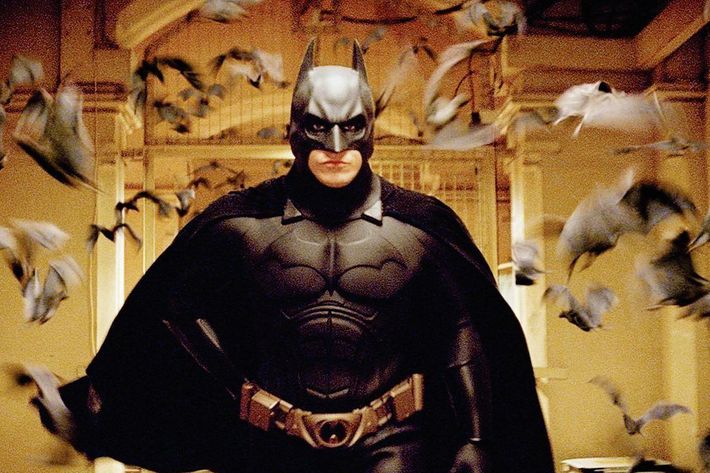
No one would’ve been surprised if this movie had bombed. There hadn’t been a widely beloved Batman movie since Keaton retired his cape and cowl in 1992, and the franchise had collapsed in ignominy nearly a decade prior to Christopher Nolan’s stab at the mythos. But from Batman Begins’ first shot, with its two-note theme music and barely visible logo, you can see that Nolan built his movie on a simple idea: Let’s do a superhero movie that’s a movie first and a superhero story second. Sure, this Batman was instantly recognizable to any Bat-fan; and sure, it’s not like it was a particularly realistic story (what with it featuring an airborne fear toxin). But there’s no self-effacing wink about this being a story inspired by a comic book. Nolan didn’t make the mistake that so many directors before (and a few after) him had made — that of assuming comics are inherently low art and that any adaptation has to be shiny or self-conscious. As the story goes, early in the film’s production, he sat the crew down, made them watch Blade Runner, then said, “This is how we’re going to make Batman.” Just as Blade Runner knew robots were as valid a narrative element as anything else, Batman Begins knows an emotionally stunted wannabe samurai can form the core of a compelling blockbuster. This movie isn’t ashamed, and that’s why it had such an impact.
6. The Incredibles (2004)
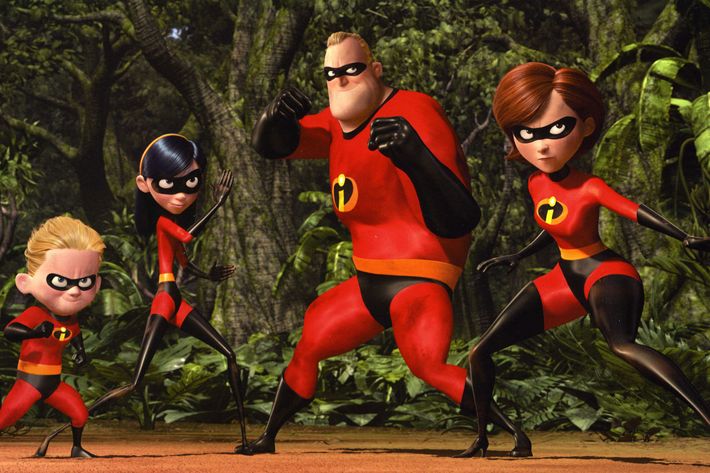
To understand the magic of this movie, we must quote that most overquoted of texts, The Big Lebowski: “Say what you want about the tenets of National Socialism, Dude — at least it’s an ethos.” The politics of The Incredibles, once you interrogate them, should be uncomfortable for a progressive audience. But its commitment to them and its eloquence in explaining them elevate this cartoon to the highest echelons of superhero-movie achievement. It is, in essence, Ayn Rand’s take on the Fantastic Four: An ungrateful populace and an overbearing government have forced the most powerful among us to hide their strength, and a devious villain plans to make everyone equally superpowered because “when everyone’s super, no one will be.” Of course, there’s plenty else here to love: a story that’s enchanting; visuals that are delicious; characters that are at once familiar and original; an admirable choice to set the action firmly in a time span of the ’50s to the ’70s; and terrific voice acting from Holly Hunter, Sarah Vowell, and Brad Bird (who, lest we forget, played diminutive fashionista Edna). But ultimately, the libertarian/objectivist ideas in the movie are what set it apart by making it more provocative and thematically ambitious than the usual good-guy-fights-bad-guy pablum.
5. The Avengers (2012)
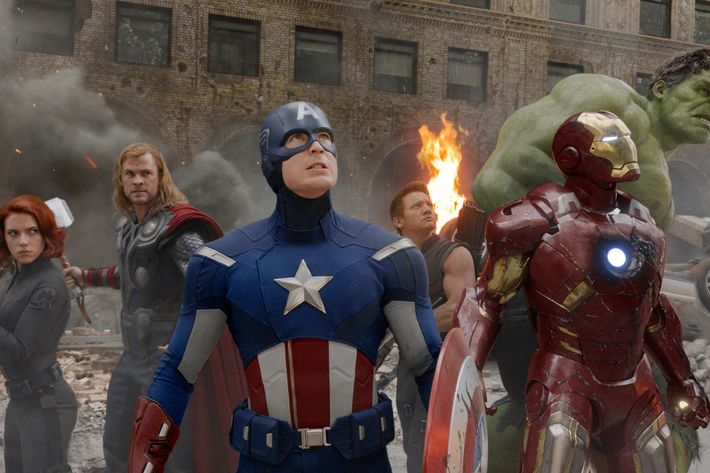
To this day, The Avengers is the Marvel Cinematic Universe’s crowning achievement. It did something no movie had ever done before: It wove together disparate characters and stories into a coherent capstone narrative that was something greater and more exhilarating than what had come before. Joss Whedon’s primary-colored epic combines an admiration for elbow-greased American know-how with an exuberant embrace of sci-fi swashbuckling. Its dialogue pops, its comedy is lithe, its character beats hit hard (“I’m always angry”), its pace never drags, and it leaves you begging for more time with the titular team. No one loves superheroes more than Whedon (let us never forget that Buffy the Vampire Slayer is still the best live-action superhero TV show of all time), and there’s never been a more pure expression of love for them than this film.
4. The Dark Knight (2008)
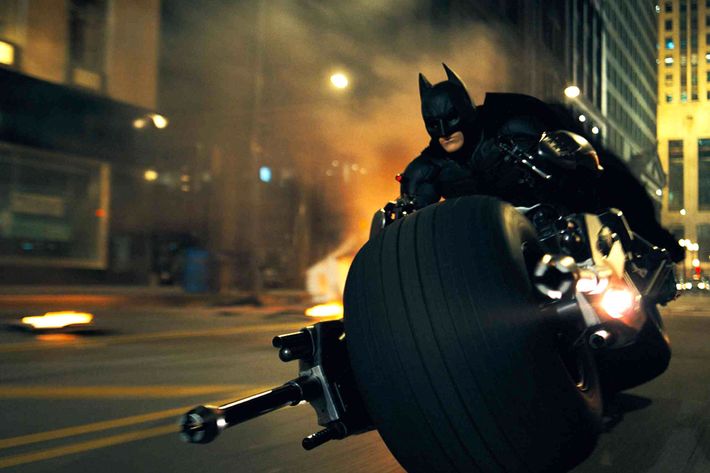
What is there to say about The Dark Knight that hasn’t already been said? I suppose we could list its flaws and plot holes (how on earth does Gordon’s faked death work? how does Two-Face’s face medically function?). But those elements hardly matter in the face of Christopher Nolan’s masterful cinematic brutalism. On one level, this is a movie with a lot of ideas about incentives and institutions — for proof, read the late polymath Aaron Swartz’s fascinating essay on the movie’s game-theory thought experiments. On another level, this is a movie built on unforgettable visuals: the disappearing pencil, the low-ceilinged makeshift Batcave, the Joker sticking his head out of a stolen cop car’s window and reveling like a dog on a road trip. But most of all, this is a master class in crafting beats — bits of storytelling that thrive individually but explode when placed in an escalating order of tension. I can’t accurately tell you how many times I’ve seen The Dark Knight because I’d have to add up all the times I’ve skipped ahead to this scene or that one, just to revel in a given moment with Heath Ledger or Christian Bale. It’s a movie that is more than the sum of its parts, but boy, each of those parts is fantastic on its own.
3. Unbreakable (2000)
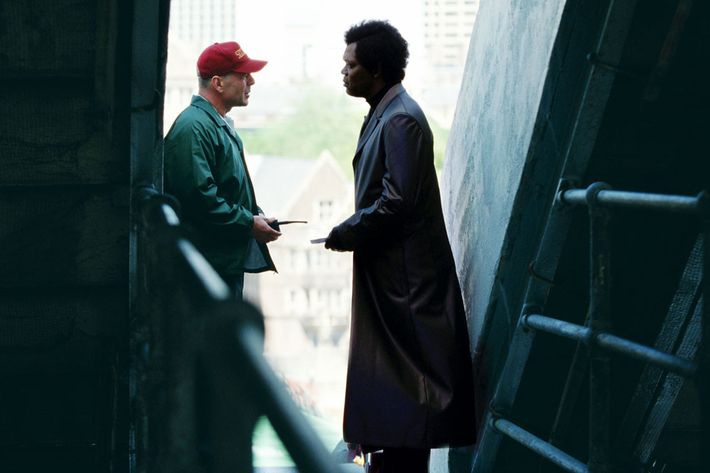
As wonderful as superhero comics are, and as much as they still provide fertile ground for movie adaptations, more filmmakers need to take M. Night Shyamalan’s cue (there’s a phrase you don’t see very often) and liberate the superhero from the shackles of licensing constraints and fan-pandering. Before the caped-crusader boom kicked in, Shyamalan crafted a movie that’s quiet, sad, delicate, intelligent, and yet unmistakably about a superhero. Well in advance of his nine-picture deal as Nick Fury, Samuel L. Jackson built his most compelling superhero-film performance as Elijah Price, a pensive and obsessive man whose dreams lead to disaster and whose origin story is intimately tied to the mid-century experiences of Philadelphia’s African-American middle class. Robin Wright crafts a woman who defies genre conventions: She isn’t a limiting shrew, and although she’s estranged from her husband, she’s tenderly making an effort to repair their marriage.
And Bruce Willis gives us David Dunn, a man whose alleged superpowers offer no flash, no ease, and little personal liberation. The third act veers a little too far into over-demonstration of his abilities, but otherwise, we see the only viscerally relatable depiction of superheroism committed to film. Unbreakable also doesn’t give us typical superhero lessons about responsibility or perseverance. It’s a story about class structures, the ways a couple can fall back into love, and the blurry line between hope and obsession. It’s a story told with long takes, calm dialogue, and nary a stitch of spandex. Just as David Dunn is touted by Elijah as the world’s first real-life superhero, this was the world’s first real-life superhero movie.
2. Logan (2017)
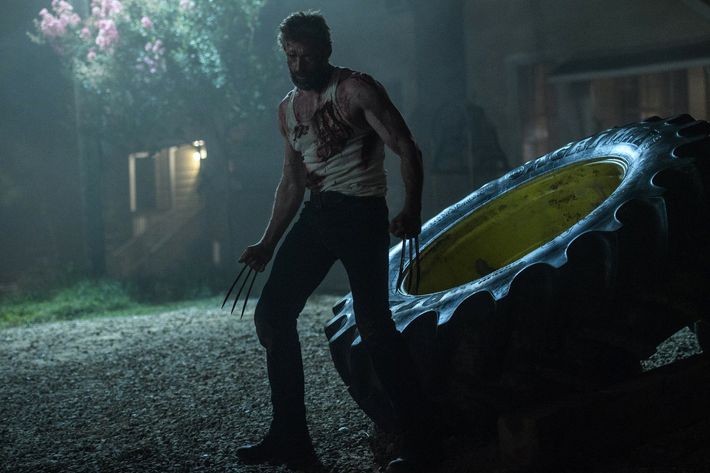
There are two factors that might lead you to conclude that James Mangold’s Logan doesn’t deserve top billing on this list. First is the fact that it doesn’t totally stand on its own — you need to at least have seen the 2000 X-Men kickoff to understand its leads and their world. Second is the violence — the film is a charnel house of severed heads and bloodstained claws. But these are ultimately merits, not missteps. At its best, the superhero genre makes an art out of the notion of the franchise, by assembling different installments into a mosaic that takes on an aggregate shape when seen from a distance. Logan is a shining example of that storytelling method, benefiting from the fact that it doesn’t have to waste time on exposition — in fact, it entrusts the viewer with nearly all explanations of what has transpired before the curtain’s rise — and rewarding our existing adoration of the title character by sending him out on a high note.
And the gore is both aesthetically rich in the mode of Peckinpah and Psycho, and purpose-serving: It serves as a visceral metaphor for our awful planet and the struggle to be a good person amid the temptations of joining its cruel inertia. Plus, the ultraviolence is something of a subversion and commentary on superhero cinema. All of these flicks are filled with despicable brutality; Logan just shows us what punches actually feel like, rather than cleaning it up for the kiddies.
Indeed, the movie is one of the only superhero pictures that feels meaningfully adult. Logan grapples with the burdens of middle age: caring for elderly parents, reconciling oneself with defiant children, confronting the meaninglessness of one’s profession, and living inside a body in decline. But though those topics may be weighty and dense with misery, the film is defiantly hopeful and believes passionately in humanity’s capacity for empathy. As the man once known as Wolverine traverses a cursed earth, we watch him overcome the hypnotic seduction of cynicism and choose to feel vulnerable. What’s more, the movie is almost deliriously funny at times, and the humor comes not from cheap pop-culture references or silly banter, but rather from naturalistic vignettes about parents and children.
Everything feels urgent and bone-deep: the dialogue, the iconography, the world-building, and the subtle rebellions against our present political situation, which never feel preachy. Plenty of super-stories are about overcoming immense obstacles, but the reasoning is usually based on negation: The hero needs to fight against evil. Here is a rare story about a superpowered individual fighting for something: love. When I use that word, I mean it not as the romantic eros, but as a curious, bloody version of the expansive agape, the embrace of our flawed species as a whole. Sure, our hero kills plenty of folks, but that’s a fine metaphor: Who among us doesn’t have trouble loving? We can only hope to move in the right direction. Logan is a tale that grabs you by the face, pulls you close, and whispers in your ear, “We’re all in this together.” Not bad for a story about a guy with big ol’ knives in his knuckles.
1. Black Panther (2018)
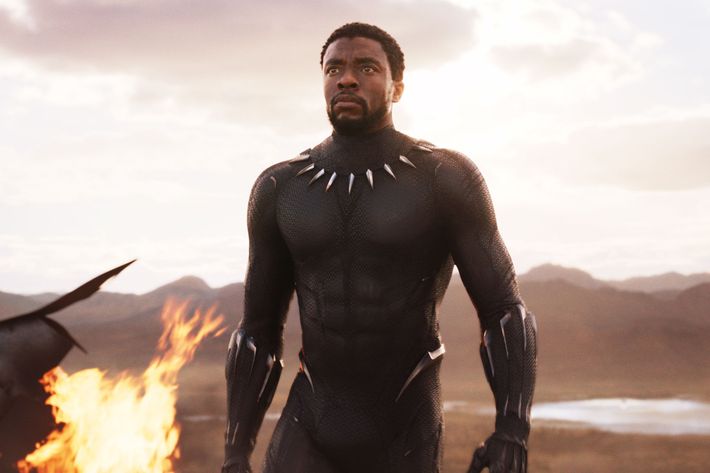
Most superhero movies are fundamentally conservative. Not necessarily politically — though all too many of them are, what with their affection for violent maintenance of the status quo. They’re artistically conservative, rarely taking risks that would challenge corporate conventional wisdom, and typically harking back with nostalgia for the past. They rarely try to invent anything or push the genre forward in a substantial way. Then, it’s 2018, 20 years into the present superhero boom, and here comes writer-director Ryan Coogler, a fierce-eyed Afrofuturist, preaching to us the gospel of the Black Panther. The character’s eponymous film is so stunning that words fail in the immediate aftermath of a first viewing. You’ve seen something not conservative, not even progressive, but downright revolutionary.
On a purely superheroic level, it fires on all cylinders. Chadwick Boseman’s titular protagonist is an instant icon thanks to his tentatively regal charisma, contemplative speech patterns, cryptic smile, perfected body, and profoundly evocative eyes. His rival, Michael B. Jordan’s Erik Killmonger, is among the best villains to ever grace the superhero genre in any medium, presenting an intimidating swagger and a persuasive master plan. Their conflict is Shakespearean in its themes, epic in its dialogue (though also prone to delightful dips into vernacular), and jaw-dropping in its climactic action. The CGI and practical effects are near-perfect and the costuming and production design, with its mix of pan-Africanism and the Apple Store, looks unlike anything we’ve seen before. Although it’s billed as a solo flick, it’s really about an African superteam, most of whom are women: Lupita Nyong’o’s Nakia, Danai Gurira’s Okoye, Letitia Wright’s Shuri, Angela Bassett’s Ramonda, and the nameless legions of the all-female fighting force known as the Dora Milaje are vividly imagined and endlessly engaging. And it’s funny as hell, to boot (Wright is a particular standout in this regard, and an early moment when she quotes an internet meme leaves one who gets the reference in tears).
But what truly sets Black Panther apart is that it envisions something no superhero movie — no major studio blockbuster of any kind, really — has ever even come close to contemplating: The complex intersection of black joy and black liberation. In the fictional African nation of Wakanda, Coogler & Co. grant us a utopia in which white colonialism never happened and people of color reached unparalleled excellence. And in the form of Killmonger, it goes one step further and asks what it means to build a utopia and keep it to oneself.
It raises urgent questions about comfort, advancement, and privilege, challenging audiences of any ethnic background to wonder whether they’re doing enough to overturn the systems that make some lives convenient at the expense of the bodies of the oppressed. If you’re watching it right, you finish the movie and feel thrilled, but also stirred to action. It forces you to think not just about the usual superheroic themes of heroism and self-sacrifice, but also about the very nature of social existence. Much in the way that 1978’s Superman made audiences believe a man can fly, Black Panther makes them believe a superhero movie can mean something.

